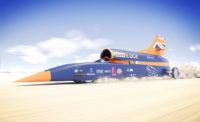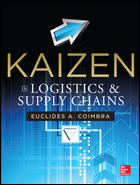The Bloodhound SSC Project is a global education initiative focused on a 1000 mph land-speed record attempt. It aims to inspire young people to pursue careers in science, technology, engineering and mathematics and its centerpiece is the Bloodhound SSC (SuperSonic Car), a 135,000 horsepower rocket- and jet-powered racing car being built in the UK by a team of Formula 1 and aerospace experts. Because this admirable objective aligns closely with one of its fundamental aims, the British Institute of NDT is sponsoring the project and will be following the progress of the Build Team as it assembles the most powerful land vehicle in history.
Bloodhound SSC will be driven by Royal Air Force fighter pilot Andy Green and powered by both a Eurofighter Typhoon EJ200 jet engine and a Falcon hybrid rocket, with a pump driven by a Cosworth Formula 1 engine. The car will be 12.8 meters long, weigh 6.5 tons empty (7.5 tons fully fuelled) and will accelerate from rest to 1000 mph and back to rest again in 100 seconds, covering 10 miles across the South African desert. With the current world land-speed record standing at 763 mph, set by Thrust SSC in 1997, also driven by Wing Commander Andy Green, this exceptional challenge is being led by former world land-speed record holder Richard Noble.
Bloodhound SSC is a mix of car and aircraft technology, with the front half being a carbon fibre monocoque, like a racing car, and the back half comprising a metallic framework and panels, like an aircraft.
Good progress has been made over the past few weeks in assembling Bloodhound’s fin. At 1,000 mph, Bloodhound will be traveling faster than any jet fighter has ever been at ground level (even faster than the remarkable Eurofighter Typhoon). This makes Bloodhound’s fin the hardest working aerodynamic fin ever.
The front and rear edges of the fin need to line up to within 2 millimeters or less, and the whole structure is stressed to survive side loads of over 5 tons. All this strength and accuracy needs to be produced from a kit of 139 precision parts held together by 5000 rivets.
The metal skins for the fin have compound curves (they curve in two different directions), so the huge panels need wheeling by hand to produce the right curvature, before hand-trimming. Then the drilling-off starts, by hand, which is an epic job. Each hole is created by back-drilling through the relevant rib with a pilot drill. The hole is initially widened to line it up and finally drilled-off to the finished size. Then the hole is counter-sunk, to create a shallow depression around the hole for the rivet head, before de-burring (removing any stray slivers of metal) completes the task. That’s four different precision hand-drilling tasks for each hole — and there are 5,000 of them on the fin alone.
Roland Dennison, Engineering Lead — Stress Analysis, thinks of the Bloodhound Project as a sort of ‘rolling laboratory’, involving continuous NDT exercises over the course of its existence: “The whole car is an active NDT experience,” he says. “NDT is carried out as part of the manufacturing process and on materials and components by suppliers. Each component is tested using the most advanced and appropriate technology available. Every test run of the car will be continuously monitored and the condition of each critical part checked, over and over again.”
As driver Andy Green puts it: “This phase of Bloodhound’s engineering is all about details. Any mistakes we make now will cost us dear when we get to the desert in South Africa and things don’t work as they should. If we’re going to have a world-class engineering adventure, and push the boundaries of physics at 1000 mph, and do it all safely, then we need to get the details right first time. It’s a fascinating process to watch as it all comes together.”
The project has attracted a world-class team of experts, with companies and individuals contributing their time and expertise to play a part in this extraordinary test of engineering.
Bloodhound SSC is also a significant educational initiative for showcasing engineering and science, and currently involves more than 5000 schools, nearly 50 universities and more than 250 colleges of further education. 1.5 million primary and secondary students have access to Bloodhound SSC in their classrooms to learn about science, technology, engineering and mathematics.
The Bloodhound SSC Show Car will be making a special guest appearance at this year’s Materials Testing Exhibition in Telford in September, an event not to be missed. In the meantime, visit www.bindt.org to register for the exhibition and for news and updates on the progress of the Bloodhound SSC project and the role of NDT and CM.
For more information, visit www.bindt.org.



